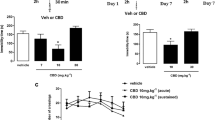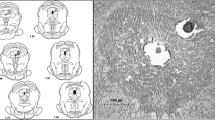Abstract
Rationale
Cannabidiol (CBD) is a non-psychotomimetic constituent of Cannabis sativa plant that promotes antianxiety and anti-panic effects in animal models after acute systemic or intra-dorsal periaqueductal gray (DPAG) administration. However, the effects of CBD repeated administration, and the possible mechanisms involved, in animal models of anxiety- and panic-related responses remain poorly understood.
Objective
The present study evaluates the role of the serotonergic neurotransmission within the DPAG in the modulation of escape responses of rats chronically treated with CBD.
Methods
Male Wistar rats received acute or repeated (5 mg/Kg/daily/21 days) administration of CBD and were submitted to the elevated T-maze (ETM). We also investigated if CBD effects on the ETM depend on facilitation of 5-HT1A-mediated neurotransmission in the DPAG. To this latter aim, we verified if these effects would be prevented by intra-DPAG injection of the 5-HT1A receptor antagonist WAY100635 (0.37 nmol/0.2 μL). Also, we verified, by in vivo microdialysis, if CBD chronic treatment increases serotonin (5-HT) release and, by quantitative polymerase chain reaction, if there are changes in 5HT-1A or 5HT-2C mRNA expression in DPAG.
Results
The results showed that repeated but not acute peripheral administration of CBD decreases escape responses in the ETM, suggesting a panicolytic effect. This treatment did not change 5HT-1A or 5-HT-2C receptor mRNA expression nor modify serotonin extracellular concentrations in the DPAG. CBD effects were prevented by DPAG injection of the 5-HT1A receptor antagonist.
Conclusions
Together, these findings suggest that repeated treatment with CBD induces anti-panic effects by acting on 5-HT1A receptors in DPAG.






Similar content being viewed by others
References
American Psychiatric Association (2000) Diagnostic and statistical manual of mental disorders, 4th ed., text revision. American Psychiatric, Washington, DC
Bambico FR, Nguyen NT, Gobbi (2009) Decline in serotonergic firing activity and desensitization of 5-HT1A autoreceptors after chronic unpredictable stress. Eur Neuropsychopharmacol 19(3):215–228
Bambico FR, Nguyen NT, Katz N, Gobbi G (2010) Chronic exposure to cannabinoids during adolescence but not during adulthood impairs emotional behaviour and monoaminergic neurotransmission. Neurobiol Dis 37(3):641–655
Bisogno T, Hanus L, De Petrocellis L, Tchilibon S, Ponde DE, Brandi I et al (2001) Molecular targets for cannabidiol and its synthetic analogues: effect on vanilloid VR1 receptors and on the cellular uptake and enzymatic hydrolysis of anandamide. Br J Pharmacol 134(4):845–852
Campos AC, Guimarães FS (2008) Involvement of 5HT1A receptors in the anxiolytic-like effects of cannabidiol injected into the dorsolateral periaqueductal gray of rats. Psychopharmacol (Berl) 199(2):223–230
Campos AC, Guimarães FS (2009) Evidence for a potential role for TRPV1 receptors in the dorsolateral periaqueductal gray in the attenuation of the anxiolytic effects of cannabinoids. Prog Neuropsychopharmacol Biol Psychiatry 33(8):1517–1521
Carrier EJ, Auchampach JA, Hillard CJ (2006) Inhibition of an equilibrative nucleoside transporter by cannabidiol: a mechanism of cannabinoid immunosuppression. Proc Natl Acad Sci USA 103(20):7895–7900
Casarotto PC, Gomes FV, Resstel LB, Guimarães FS (2010) Cannabidiol inhibitory effect on marble-burying behaviour: involvement of CB1 receptors. Behav Pharmacol 21(4):353–358
Cassano T, Gaetani S, Macheda T, Laconca L, Romano A, Morgese MG et al (2011) Evaluation of the emotional phenotype and serotonergic neurotransmission of fatty acid amide hydrolase-deficient mice. Psychopharmacol (Berl) 214(2):465–476
Castro ME, Diaz A, del Olmo E, Pazos A (2003) Chronic fluoxetine induces opposite changes in G protein coupling at pre and postsynaptic 5-HT1A receptors in rat brain. Neuropharmacology 44(1):93–101
Castro E, Díaz A, Rodriguez-Gaztelumendi A, Del Olmo E, Pazos A (2008) WAY100635 prevents the changes induced by fluoxetine upon the 5-HT1A receptor functionality. Neuropharmacology 55(8):1391–1396
de Paula Soares V, Zangrossi H Jr (2004) Involvement of 5-HT1A and 5-HT2 receptors of the dorsal periaqueductal gray in the regulation of the defensive behaviors generated by the elevated T-maze. Brain Res Bull 64(2):181–188
de Souza Silva MA, Mattern C, Topic B, Buddenberg TE, Huston JP (2009) Dopaminergic and serotonergic activity in neostriatum and nucleus accumbens enhanced by intranasal administration of testosterone. Eur Neuropsychopharmacol 19(1):53–63
Deiana S, Watanabe A, Yamasaki Y, Amada N, Arthur M, Fleming S, Woodcock H, Dorward P, Pigliacampo B, Close S, Platt B, Riedel G (2011) Plasma and brain pharmacokinetic profile of cannabidiol (CBD), cannabidivarine (CBDV), Δ(9)-tetrahydrocannabivarin (THCV) and cannabigerol (CBG) in rats and mice following oral and intraperitoneal administration and CBD action on obsessive-compulsive behaviour. Psychopharmacol (Berl) 219(3):859–873
Devane WA, Hanus L, Breuer A, Pertwee RG, Stevenson LA, Griffin G et al (1992) Isolation and structure of a brain constituent that binds to the cannabinoid receptor. Science 258(5090):1946–1949
Elbatsh MM, Assareh N, Marsden CA, Kendall DA (2012) Anxiogenic-like effects of chronic cannabidiol administration in rats. Psychopharmacol (Berl) 221:239–247
Fusar-Poli P, Crippa JA, Bhattacharyya S, Borgwardt SJ, Allen P, Martin-Santos R et al (2009) Distinct effects of {delta}9-tetrahydrocannabinol and cannabidiol on neural activation during emotional processing. Arch Gen Psychiatry 66(1):95–105
Gomes FV, Resstel LB, Guimarães FS (2011) The anxiolytic-like effects of cannabidiol injected into the bed nucleus of the stria terminalis are mediated by 5-HT1A receptors. Psychopharmacol (Berl) 213(2–3):465–473
Graeff FG, Viana MB, Tomaz C (1993) The elevated T maze, a new experimental model of anxiety and memory: effect of diazepam. Braz J Med Biol Res 26(1):67–70
Graeff FG, Netto CF, Zangrossi H Jr (1998) The elevated T-maze as an experimental model of anxiety. Neurosci Biobehav Rev 23(2):237–246
Guimarães FS, Chiaretti TM, Graeff FG, Zuardi AW (1990) Antianxiety effect of cannabidiol in the elevated plus-maze. Psychopharmacol (Berl) 100(4):558–559
Hershkowitz M, Szechtman H (1979) Pretreatment with delta 1-tetrahydrocannabinol and psychoactive drugs: effects on uptake of biogenic amines and on behavior. Eur J Pharmacol 59(3–4):267–276
Karrenbauer BD, Müller CP, Ho YJ, Spanagel R, Huston JP, Schwarting RK, Pawlak CR (2011) Time-dependent in-vivo effects of interleukin-2 on neurotransmitters in various cortices: relationships with depressive-related and anxiety-like behaviour. J Neuroimmunol 237(1–2):23–32
Kiser RS, Brown CA, Sanghera MK, German DC (1980) Dorsal raphe nucleus stimulation reduces centrally-elicited fearlike behavior. Brain Res 191(1):265–272
Mato S, Vidal R, Castro E, Díaz A, Pazos A, Valdizán EM (2010) Long-term fluoxetine treatment modulates cannabinoid type 1 receptor-mediated inhibition of adenylyl cyclase in the rat prefrontal cortex through 5-hydroxytryptamine 1A receptor-dependent mechanisms. Mol Pharmacol 77(3):424–434
Mechoulam R, Ben-Shabat S, Hanus L, Ligumsky M, Kaminski NE, Schatz AR et al (1995) Identification of an endogenous 2-monoglyceride, present in canine gut, that binds to cannabinoid receptors. Biochem Pharmacol 50(1):83–90
Mishima K, Hayakawa K, Abe K, Ikeda T, Egashira N, Iwasaki K et al (2005) Cannabidiol prevents cerebral infarction via a serotonergic 5-hydroxytryptamine1A receptor-dependent mechanism. Stroke 36(5):1077–1082
Moreira FA, Aguiar DC, Guimarães FS (2006) Anxiolytic-like effect of cannabidiol in the rat Vogel conflict test. Prog Neuropsychopharmacol Biol Psychiatry 30(8):1466–1471
Moreira FA, Aguiar DC, Campos AC, Lisboa SF, Terzian AL, Resstel LB, et al. (2009) Antiaversive effects of cannabinoids: is the periaqueductal gray involved? Neural Plast 625469
Moulin-Sallanon M, Charnay Y, Ginovart N, Perret P, Lanfumey L, Hamon M et al (2009) Acute and chronic effects of citalopram on 5-HT1A receptor-labeling by [18F]MPPF and -coupling to receptors-G proteins. Synapse 63(2):106–116
Nogueira RL, Graeff FG (1995) Role of 5-HT receptor subtypes in the modulation of dorsal periaqueductal gray generated aversion. Pharmacol Biochem Behav 52(1):1–6
Onaivi ES, Green MR, Martin BR (1990) Pharmacological characterization of cannabinoids in the elevated plus maze. J Pharmacol Exp Ther 253(3):1002–1009
Paxinos G, Watson C (1997) The rat brain in stereotaxic coordinates. Academic, New York
Paxinos G, Watson C (2007) The rat brain in stereotaxic coordinates, 6th edn. San Diego, Academic
Pinheiro SN, Del-Ben CM, Zangrossi H Jr, Graeff FG (2008) Anxiolytic and panicolytic effects of escitalopram in the elevated T-maze. J Psychopharmacol 22(2):132–137
Pobbe RL, Zangrossi H Jr (2005) 5-HT(1A) and 5-HT(2A) receptors in the rat dorsal periaqueductal gray mediate the antipanic-like effect induced by the stimulation of serotonergic neurons in the dorsal raphe nucleus. Psychopharmacol (Berl) 183(3):314–321
Poltronieri SC, Zangrossi H Jr, de Barros Viana M (2003) Antipanic-like effect of serotonin reuptake inhibitors in the elevated T-maze. Behav Brain Res 147(1–2):185–192
Resstel LB, Joca SR, Moreira FA, Corrêa FM, Guimarães FS (2006) Effects of cannabidiol and diazepam on behavioral and cardiovascular responses induced by contextual conditioned fear in rats. Behav Brain Res 172(2):294–298
Rock EM, Bolognini D, Limebeer CL, Cascio MG, Anavi-Goffer S, Fletcher PJ et al (2011) Cannabidiol, a non-psychotropic component of cannabis, attenuates vomiting and nausea-like behaviour via indirect agonism of 5-HT(1A) somatodendritic: Autoreceptors in the Dorsal Raphe Nucleus. Br J Pharmacol. doi:10.1111/j.1476-5381.2011.01621.x
Roy-Byrne PP, Craske MG, Stein MB (2006) Panic disorder. Lancet 368:1023–1032
Russo EB, Burnett A, Hall B, Parker KK (2005) Agonistic properties of cannabidiol at 5-HT1a receptors. Neurochem Res 30(8):1037–1043
Schenberg LC, Bittencourt AS, Sudré EC, Vargas LC (2001) Modeling panic attacks. Neurosci Biobehav Rev 25(7–8):647–659
Soares Vde P, Campos AC, Bortoli VC, Zangrossi H Jr, Guimarães FS, Zuardi AW (2010) Intra-dorsal periaqueductal gray administration of cannabidiol blocks panic-like response by activating 5-HT1A receptors. Behav Brain Res 213(2):225–229
Teixeira RC, Zangrossi H, Graeff FG (2000) Behavioral effects of acute and chronic imipramine in the elevated T-maze model of anxiety. Pharmacol Biochem Behav 65(4):571–576
Thomas A, Baillie GL, Phillips AM, Razdan RK, Ross RA, Pertwee RG (2007) Cannabidiol displays unexpectedly high potency as an antagonist of CB1 and CB2 receptor agonists in vitro. Br J Pharmacol 150(5):613–623
Viana MB, Tomaz C, Graeff FG (1994) The elevated T-maze: a new animal model of anxiety and memory. Pharmacol Biochem Behav 49(3):549–554
Zangrossi H Jr, Graeff FG (1997) Behavioral validation of the elevated T-maze, a new animal model of anxiety. Brain Res Bull 44(1):1–5
Zanoveli JM, Nogueira RL, Zangrossi H Jr (2003) Serotonin in the dorsal periaqueductal gray modulates inhibitory avoidance and one-way escape behaviors in the elevated T-maze. Eur J Pharmacol 473(2–3):153–161
Zanoveli JM, Nogueira RL, Zangrossi H Jr (2007) Enhanced reactivity of 5-HT1A receptors in the rat dorsal periaqueductal gray matter after chronic treatment with fluoxetine and sertraline: evidence from the elevated T-maze. Neuropharmacology 52(4):1188–1195
Zanoveli JM, Carvalho MC, Cunha JM, Brandão ML (2009) Extracellular serotonin level in the basolateral nucleus of the amygdala and dorsal periaqueductal gray under unconditioned and conditioned fear states: an in vivo microdialysis study. Brain Res 1294:106–115
Zanoveli JM, Pobbe RL, de Bortoli VC, Carvalho MC, Brandão ML, Zangrossi H Jr (2010) Facilitation of 5-HT(1A)-mediated neurotransmission in dorsal periaqueductal grey matter accounts for the panicolytic-like effect of chronic fluoxetine. Int J Neuropsychopharmacol 13(8):1079–1088
Zuardi AW, Shirakawa I, Finkelfarb E, Karniol IG (1982) Action of cannabidiol on the anxiety and other effects produced by delta 9-THC in normal subjects. Psychopharmacol (Berl) 76(3):245–250
Zuardi AW, Guimarães FS, Moreira AC (1993) Effect of cannabidiol on plasma prolactin, growth hormone and cortisol in human volunteers. Braz J Med Biol Res 26(2):213–217
Acknowledgments
This work was supported by CNPq and FAPESP grants. We thank Afonso Paulo Padovan and Eleni Tamburus for their technical support. ACC, VPS, and FRF were FAPESP fellowship recipients. MCC and MAV are CNPq fellowship recipients.
Conflict of interest
Authors do not report any conflict of interest.
Author information
Authors and Affiliations
Corresponding author
Rights and permissions
About this article
Cite this article
Campos, A.C., de Paula Soares, V., Carvalho, M.C. et al. Involvement of serotonin-mediated neurotransmission in the dorsal periaqueductal gray matter on cannabidiol chronic effects in panic-like responses in rats. Psychopharmacology 226, 13–24 (2013). https://doi.org/10.1007/s00213-012-2878-7
Received:
Accepted:
Published:
Issue Date:
DOI: https://doi.org/10.1007/s00213-012-2878-7




